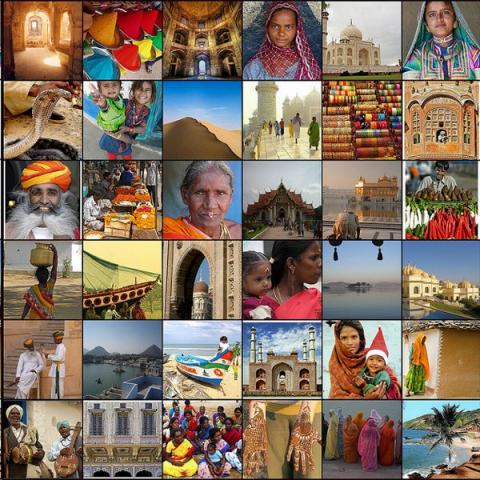India Might Rule the World One Day… Let’s Discuss

Since the collapse of the Soviet Union, theories of the exact paradigm of the global power structure have been debated… and debated. First, the United States stood alone, the unilateral power over all that it surveyed. Next, the acronyms of transnational unions were to become more powerful -- the EU, MERCOSUR, CARICOM and ASEAN. They did not shift the international power structure. Today, China is considered a country on the verge of challenging the United States for global supremacy, even though it excludes most citizens from political participation and will face population instability due to its One-Child Policy.
India has not had any problems producing a birthrate to support the world’s second-most populous nation. They have a highly educated workforce. Anyone, from anywhere, that has needed tech support knows their telecommunications infrastructure works. They are creating their own products to meet the growing material demands of Indian citizens, if in Bombay, take a ride in any of Tata Motors Indian-built automobiles. Since the turn of the century, India has become a hotbed for computing innovations. First, they assisted American companies to avoid any Y2K complications. Today, Indian technology entrepreneurs are creating intellectual property to compete on the global market.
Sheer Numbers
India is big. Geographically, it is referred to as a subcontinent. Cartographers do not throw out the term lightly ( just ask Madagascar). India is home to a staggering 1.22 billion people. This means that it is the world’s largest democracy. India has had peaceful transitions in leadership and the military is under civilian control throughout their history.
According to the International Monetary Fund, India had the third-largest Gross Domestic Product (GDP) in the world, behind the United States and China and was the fourth-largest economic entity (the European Union had the world’s largest GDP). That is nothing to sneeze at.
Nonaligned to all the right places…
Since India’s independence from Great Britain in 1947, India has a history of going against the trend in the international arena. During the Cold War, they chose neither the Soviet Union’s communist bloc nor to side with the United States and Western Europe. Instead, India “nonaligned” itself and stayed out of the disputes between the world’s two super powers. In retrospect, the Nonaligned Movement was a nonstarter, empty rhetoric that did not elevate India’s poverty or general standing in the world vis-à-vis the world’s powers post War World II.
The one thing the Nonaligned Movement did set the foundation for is India opening diplomatic relations and dialogue with other nation-states beyond its immediate sphere of influence (Bhutan, Sri Lanka, Nepal, and Bangladesh). India now has a history of cooperation with other former European colonies in developing economies and prosperous trade relations.
Nuclear Ambitions
India is in the club with the United States’ blessing. They have the bomb, which hopefully means a Bollywood version of Dr. Strangelove is in the works. This gives India legitimacy in its relations with its neighbors and other large countries such as the United States or China.
India is starting to push beyond its borders and deepen its economic ties with its neighbors. They have offered a more extensive free-trade agreement with Sri Lanka, built hydro-electric dams in Bhutan and even allow garlic to be imported from Pakistan. Like China, they will need more resources and markets for their increased entrepreneurship. India is just beginning to take steps into a bigger world.

There are a few obstacles…
Where to begin? Since there is a large population in India and it is still a developing country, there are a lot of poor people in India. The poverty rate has “dropped” to 29.8 percent (the United States poverty rate is between 15 and 16 percent). The slowdown in the global economy has ended India’s run of double-digit growth for the last six years, according to the Economist, India will only have a projected economic growth of 5.3 percent in 2012.
Staying inside India, the infrastructure is crumbling, with recent blackouts at the end of July (more than 600 million people were without power for two days). India needs to redouble its efforts to make it friendlier for internal and external investors. Also the bureaucracy is a living nightmare with enough red tape to frustrate even the most diligent of reformers. It is going to take sustained public and private efforts to reduce India’s bureaucratic waste.
Then there is India and Pakistan’s blood feud. They have fought three blood wars since each country’s independence in 1947. They have turned the Kashmir, a disputed piece of land, into one of the world’s leading hotspots for potential war. India does not have the best relationship with China. They fought a war in 1962 (China won) and have disputed their border with China ever since.
Superpower Status
India has the demographics, 20 percent of the world’s 6.7 billion population, economic heft and educated populace to help shape the future of the world. There is no doubt India deserves a larger say in international affairs with a permanent seat on the United Nations’ Security Council. As India and China’s trade relations improve and become intractable and even a working relationship with Pakistan that will allow both countries to divert resources away from military buildups, it will leave India with increasing resources to be more influential on the world stage.
The world’s former colonies are closing the gap as Brazil too cleans up corruption, improves its infrastructure and begins to project its power in South America and the world. South Africa has hosted a World Cup and has slowly improved the prosperity of all its citizens. Sure, these places have their problems. As the world’s interconnectivity becomes greater, it is a good bet that India, aligned or nonaligned, will be able to shoulder more of the world’s leadership burden.
Author Bio:
Kurt Thurber is a contributing writer at Highbrow Magazine. He Holds a Bachelor’s Degree in Political Science and a Master’s Degree in International Relations.




























































































































































































































































































































